September 17, 2019
 by Chintan Zalani / September 17, 2019
by Chintan Zalani / September 17, 2019

In the last two decades, the SaaS market has exploded.
To stand out in a saturated market, SaaS companies need to utilize content marketing to help develop a brand. Lydia Roth, a digital marketing manager at Alexa, feels that brands go astray in their content efforts.
She notes:
“Many SaaS companies fail to consider the entire customer journey. It’s easy to become of the mindset that, if you’re creating content that doesn’t lead to a new customer, it’s a waste of time.”
That’s not true. Lydia sums up how to practice effective content marketing: researching what your audience needs, using the right keywords for their queries, and discovering the pain points they have.
Are you a SaaS company overwhelmed by the information above? Well, don’t worry. You’re in the right place for launching or refining your content campaign.
In this article, we dissect four SaaS companies doing content marketing right, as well as insight into how the pros are achieving success via their marketing ideas. Are you ready to soak the wisdom from these successful SaaS companies and apply them to catapult your business?
Let’s get to it.
| Related: Read what the saturation of the SaaS industry means for buyers. |
The following four companies are showing the world what a content marketing team should be doing, and how to do it well: Contently, Databox, Groove, and Mailchimp.
Contently started as a marketplace for creative talent, but grew into helping brands become publishers. Currently, they are a content marketing solution for enterprises, hosting over 140K writers, filmmakers, and designers on their network.
| TIP: Seeking a content creation software solution for your business? View all of your options with real user reviews right on G2. |
So how do you content market a content marketing solution? More importantly, you have to attract and appeal to two different kinds of audiences: enterprises and freelance creatives?
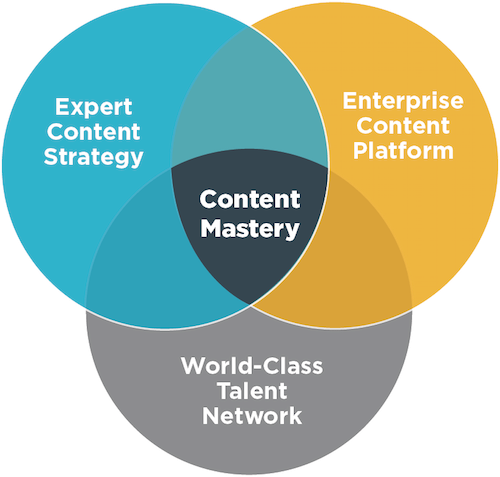
We spoke to Joe Lazauskas, Head of Marketing, to understand their strategy.
Contently starts with the following litmus test before content production:
“Each piece of content we publish has to help our target audience in a way that no one else can. If we do that day after day, we know the business results will follow.”
For both of their publications, Contently has a documented strategy laying out their goals, KPIs, audience personas, and the pillars of their program. Each piece of content they produce needs to slot into that framework in some way. He elaborates on the brand’s distinct content strategies for both of their audiences.
Let’s first look at their blog for freelance creatives:
“The Freelancer is the primary way we grow our creative network and the visitors to the blog sign up for the network at an astonishingly high rate (13% conversion rate). The goal of our content is simple: We want to help freelancers make more money, and do it with us if they can. In our Secrets from Contently's Top-Earning Freelancers article, we want to empathize with the unique challenges they face as freelancers, which many of us know well. I was once a Contently freelancer. So are several others on the team.”
For marketers, the company runs The Content Strategist. “On this blog, we tackle the big content challenges marketers face today: creating a content strategy, evangelizing content inside their organization, aligning their teams, and figuring out how to actually create high-quality content.
“When we launched it six years ago, we wanted to be the publication of record for the content marketing industry. Now that everyone's writing about content marketing, our goal is to become the best educational resource out there.”
He goes on to say:
“We don't have a boundary between Content and Marketing teams. Everyone on our marketing team is a content creator in some way; their individual functions just focus on different parts of the funnel (like lead gen vs. sales enablement). Although we're scrappy; everyone touches each function in some way.”
It was intriguing to learn that the sales team can place content requests.
“We get constant input from our sales team and have a standing slot at their weekly meeting to give content updates and solicit ideas. We also have a feature within Contently called Content Requests, in which the Sales Team can request content they need to be successful.
“On the Freelancer version, we do everything in close partnership with the Content Services team, which officially owns that program. After all, they work with our freelancers every day. They know them best. And they're responsible for the business results that program drives.”
And then? There's organic traffic:
“Organic traffic accounts for over 80% of our leads. Email is the biggest channel for us; we have a large, loyal audience that subscribes to our content. After that, it's direct; people come to our site and fill out a demo request form. Then search, which drives a huge portion of our traffic, but naturally, a lower share of leads as a referral source.”
The brand doesn't see a huge amount of traffic from social media.
“We promote across social, although honestly, it's more important to create something that your audience will be inspired to share than pushing it out yourself.
The vast majority of social traffic comes from other people sharing it. If we have something we're really excited about, like our content strategy course, we'll share that on Facebook and LinkedIn groups for marketers, which tends to get a great response. We also leverage the individual networks of everyone on our sales and marketing teams.”
Contently has matured in the way they measure the business results generated from their content.
“We now take a much more full-funnel view of our content performance than we did when we launched. We're focused not only on how much traffic and how many leads we're driving through content but also on the impact that content has on each stage of the journey.
How are we nurturing leads until they're marketing qualified leads (MQLs)? How are we creating content that helps our sales team turn those MQLs into opportunities, and then convert those opportunities into wins at a higher rate? The principle is the same as with everything else: you need to create content that helps people. But the tactics are different.
There are more account-based marketing tactics like creating content for very specific, high-compliance industries, and content that relates to buying Contently (like PQLs that give them a glimpse of what using our solution is like).”
Content marketing for a data company like Databox is simple. Just put together industry trends and all things data. If done badly, it can quickly become impersonal and make for a dry experience for the visitors. However, Databox chooses a collaborative approach in its marketing with an overused tactic in the marketing niche: roundups.
| TIP: You might be in the market for data visualization software, so it's important to see real user reviews on software like Databox to help you make the right decisions for your company. Read their unbiased, real reviews on G2. |
The Databox team shared that they have had more than 3500 individuals over the last two years contributing to their blog. It's an incredible feat, especially given that their roundups are insightful.
Pete Caputa, CEO at Databox, shares the process the brand uses for compiling such pieces:
“Every week, we come up with new article ideas, and then we reach out to experts on each topic. We ask them to answer a few questions, and then we weave their quotes into an article. Every article we write about has contributions from at least 25 people, and for some articles, we have had almost 200 contributors.”
Caputa believes that their roundups are full of learning, which is why they do a lot of them.
“Because we have ample contributors, these articles end up being a very thorough coverage of the topic. For example, we recently published an article listing out the 22 email marketing metrics everyone should be tracking.
We also love it because we learn something new every time we compile an article. And our contributors often tell us that they do too. We recently crowdsourced a Local SEO checklist, and an agency owner from Australia said she used it to ensure she didn't miss anything for a recent client. We don't have anyone in-house with a lot of expertise in this subject and would have never been able to write it ourselves.”
The brand’s blog posts contextually link to relevant dashboard templates of the product and creating a little brand awareness.
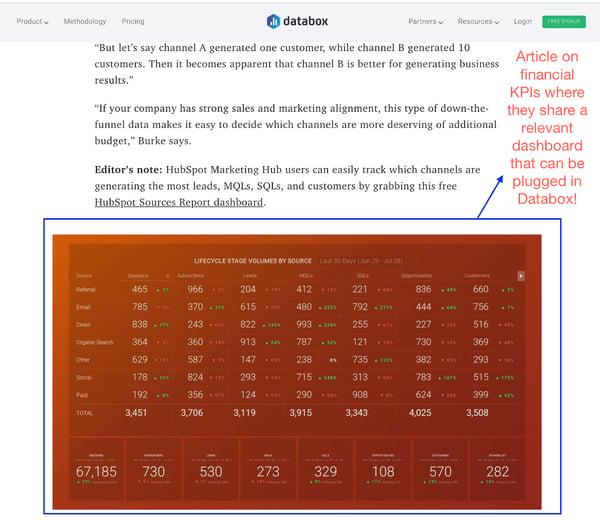
One major reason they manage so many contributors is repeated participation.
“We're able to get so many people to contribute because we always quote them and link to their website or social profile when we do. We even ask our contributors for suggestions for topics and have also featured them in the content we've written for other websites. We have a lot of repeat contributors, as a result.”
And guess what? The process also results in new customers.
“These strong relationships we form throughout this process often lead to customer relationships too. Because the content we publish is related to what we do or one of the 70+ integrations we've built, our contributors often check out our free product."
In terms of tangible results, the Databox blog has paved the way to over 100K monthly sessions.
“Our content marketing has helped us grow our traffic from just a few thousand sessions to nearly 100k sessions per month. This traffic results in 4,000 new signups for our free product and 100+ new paying customers every month.”
| TIP: Databox's contributor structure makes a case for more B2B companies to get creative with how they are creating content. Learn more about how to work smarter by leveraging user-generated content. |
Sharing the financial details and the bumps of your business are scary. However, transparency has become a cornerstone for many successful companies today. Groove was among the first few businesses that openly documented their growth.
| TIP: Are you currently looking for a customer service and helpdesk platform? Why not see what other users are saying about GrooveHQ before making a decision for yourself? |
The company’s Founder, Alex Turnbull, shares how content marketing turned around the failing startup. Their traffic rose to 250,000 visitors per month, relying on content alone as their marketing channel. And their revenue grew to $5M per year in a short span of three years.

Groove initially didn’t take content seriously, and their results weren’t impressive. However, they decided to refresh their strategy and stop doing things that “looked nice” on the blog.
First, they spent a few weeks hanging out in small business communities and researching the needs of the market. As they wanted to stand out from other business blogs, Groove made a deliberate decision to not focus on customer service-related content.
At that time, no other publication focused on the “real story” of small businesses, their struggles, challenges, and wins. So that’s what they decided to do on their blog relaunch with a live revenue progress bar. Even with the revelation of their “embarrassing” financials, they garnered 1000 subscribers within 24 hours.
And the number bumped to 5000 in a month.
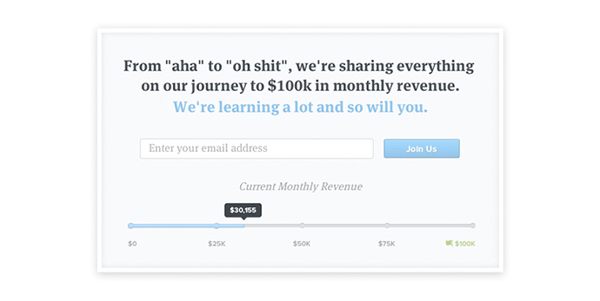
The reason the Groove blog grew at a brisk pace was their relentless focus on the audience. Alex would chime in with new customers and enquire the struggles they were facing.
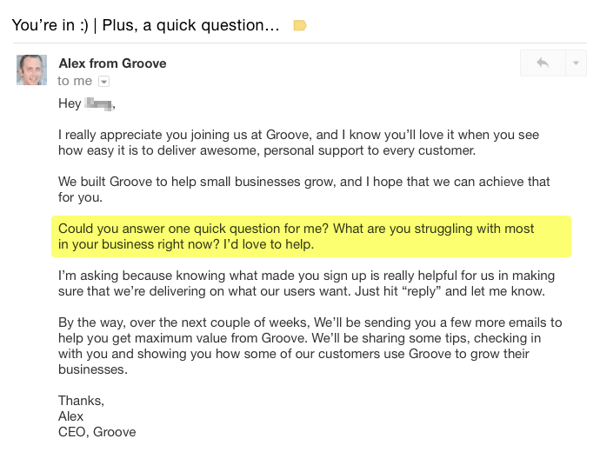
Alex and Co. mobilized the startup community to rally around and hoot for their brand. They reached out to influencers for feedback and impressed them with their transparency. A major reason their content was resonating with entrepreneurs was because of their heartfelt stories.
In one instance, the company shared how adding a story at the top increased the engagement on their posts.
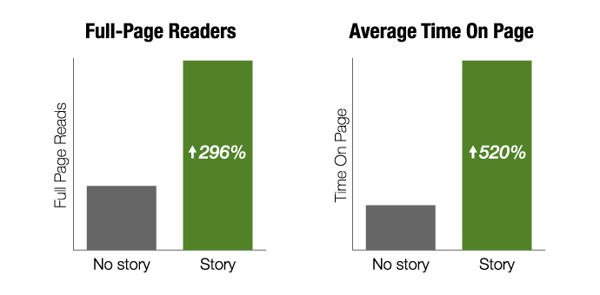
Aaron Orendorff, Founder of iconiContent, shares how the software company made strides with stories:
"Since its inception, Groove’s ‘Journey to $100k’ was an anchor for both its brand and content. It established an ethos and put a human face on what would otherwise have been merely software. Today, the Journey continues: Alex’s recent post, ‘Why I Almost Walked Away’ is brand storytelling at its best: raw, honest, and hopeful.”

If you dissect their site, six out of the 12 most linked pages (all of them with over 100 referring domains) are business case studies of Groove. They are personal and real tales of the brand.
Aaron elaborates how the company sees the role of content today:
“The goal of content has evolved into a single purpose: growth, to serve the funnel by serving our audience. This means uniting audience goals with business goals.”
He goes on to share an example of their almost 6000-word blog post on customer service skills:
“The post shines on both fronts. It’s a lengthy piece with detailed definitions, examples, and five-step instructions on each skill: serve our audience. Naturally, it’s built around a high-volume keyword for awareness and to drive organic traffic.
But rather than gate the long-form version behind a landing page (which is how most B2B organizations approach content), instead we created a short-form version: a boiled down slide deck, and seeded contextual calls-to-action throughout the ungated version: serve the funnel.”
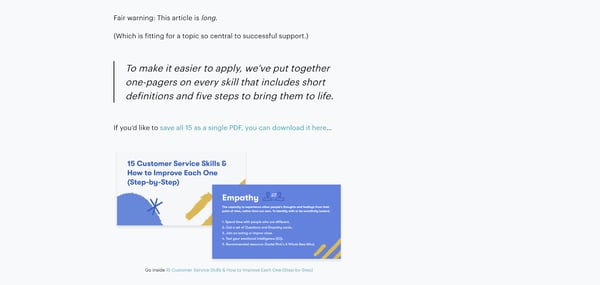
The beloved small business brand started in 2001 as an email marketing software platform and have now expanded into a full-stack marketing platform.
One of the earliest marketing strategies the brand leveraged was going from paid to freemium. It helped them grow from 85,000 to 450,000 users in a year. Let’s get into a few of their content, marketing, and business strategies.
| TIP: Do you already use Mailchimp as your all-in-one marketing platform? Or are you on the fence about diving in? Either way, read user reviews to see how people feel about Mailchimp to help you make a more informed decision for yourself. |
On the content and branding front, Mailchimp’s game has always been strong. They have a ‘resources’ section with marketing tips and high-quality articles for their audience of small businesses. To understand Mailchimp’s services and features, they have step-by-step tutorials to get started and master their product.

They also have a marketing glossary, and recently began publishing transparency reports to share how they handle the requests for disclosure of information in their user accounts.
Mailchimp publicly released its internal content style guide that facilitates better communication between its employees. It’s so useful that it serves as a gold standard for many businesses now.
Ahrefs shows that over 1.6K domains refer it!

A few of their top linked pages from the resources section are based on original research of their email software. It shows how you can leverage original data to add value to your community and simultaneously get the word out about your product.
Besides being helpful, Mailchimp is no stranger to eccentric marketing campaigns. Once the brand delivered high-quality merch, including shirts, hats, and other swag to new customers. The numbers below depict the success of the campaign.
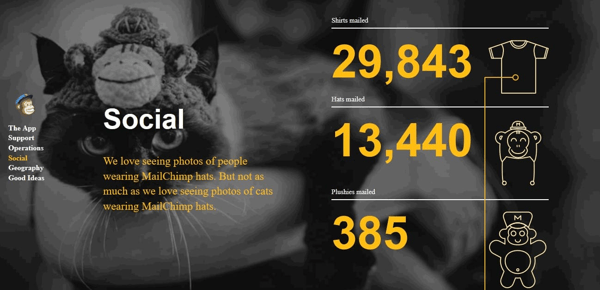
The brand also launched an ingenious campaign that centered around the mispronunciation of its name.
It consisted of audio and video ads like this one:
Regularly running such creative campaigns has helped Mailchimp get recognized as a friendly and fun brand that doesn’t take itself too seriously.
So far we’ve seen numerous out of the box strategies that the software company used to become a memorable brand. However alongside its platform expansion, the brand has pulled off a massive stunt.
The beloved brand announced creation of an in-house entertainment studio for creating original series (including fiction, unscripted, mockumentary, and podcasts) for entrepreneurs.
Its show network is called Mailchimp Presents:
Is it a timely move? Well, video is eating the internet, and original shows with great storytelling are a great way to find a place in your audience’s lives.
Jay Acunzo, Founder of Marketing Showrunners, aptly summarizes how brands can leverage serialized content:
"The marketing mandate used to be to grab attention. No longer. Today, the best marketers know their jobs are to hold attention. Creating serialized content is one of the most proven and audience-centric ways to do this. By breaking apart a series into three component parts: a show-level concept, an episode-level structure, and on-air or on-camera talent, teams can more easily craft shows in strategic ways that actually work for the brand."
Modern marketing is about creating a great experience for your audience. Mailchimp has depicted thought leadership and is now a part of the lives of its audience on the go with episodes between five to eight minutes long. The brand continues to average more than one show original series per month right now.
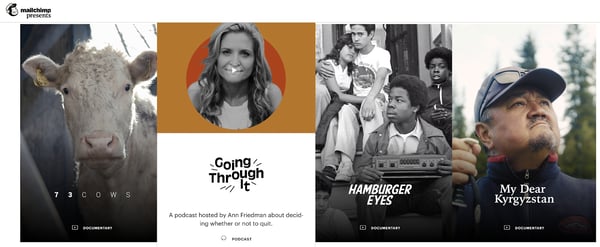
The cutthroat competition in the SaaS industry calls for moving beyond the usual content creation. Shows are incredibly valuable to be present in the lives of your prospects even before they need your products and connect more deeply with your current customers.
Does content marketing work in dull niches? We’re here to share a bonus example from the information security industry proving it does.
We spoke to Content Marketing Expert Andra Zaharia, and she elaborated on the distinct strategy of KnowBe4, a company focused on cybersecurity awareness training.
Security is a challenging and impactful defense layer of any organization, so their product has a dire market need. However, Andra highlights how the brand rarely falls back to FUD (Fear, Uncertainty, and Doubt) to market their product.
“Their approach is constructive and demonstrates the nuances of cybercriminal tactics involving psychological triggers (called social engineering) in a very practical manner, empowering people to protect against them effectively.”
If you look at their content marketing strategy, you’ll find a range of content formats and presence on many channels.They have eBooks, tip sheets, white papers, reports, an active blog, security tools, and a podcast which includes a 12-episode series on security awareness called ‘The Inside Man’.
What’s more, the brand also works with one of the world's greatest hackers, Kevin Mitnick, to reach beyond the confines of the cybersecurity industry.
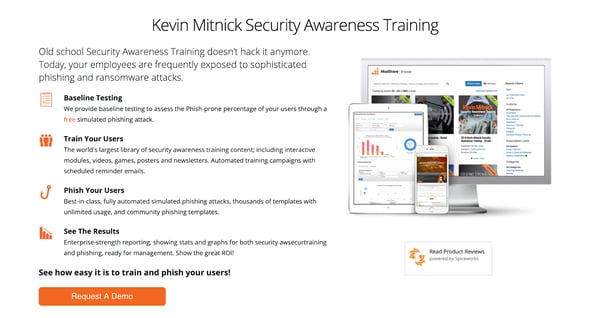
Zaharia shares the two specific aspects that stand out for her in the content marketing strategy of the cybersecurity company.
“Their focus and alignment are evident in everything they do, content-wise. They have established themselves as one of the companies that truly excel at cybersecurity awareness training, covering the topic both in terms of breadth and depth.
Secondly, their tone of voice is invigorating and human. Their use of language and their approach trigger curiosity and frame cybersecurity awareness training as a rewarding and fun process (the exact opposite of how it’s usually perceived). They are working not just to strengthen their positioning, but to change people’s perception of security awareness training.”
Content marketing is a great way to build a scalable brand awareness engine for your SaaS. As you saw, blogging strategically (keeping saas SEO in mind) still works well. If you also build relationships along the way, then it won’t take time to see an upward traffic trajectory.
However, weaving your brand’s story into your content strategy is key to create a memorable experience for your audience.
Need more content marketing inspiration? Learn some takeaways from the Content Tech Summit 2019 or check out our rundown of savvy content marketing examples.
Chintan is a writer and an ROI-focused content marketer. You can get in touch with him at Elite Content Marketer if you want to grow your business through content.
Behind every purchase a consumer makes, there is a decision-making journey.
 by Ryan Prior
by Ryan Prior
In some ways, gated content relies on that old cliche: you want what you can’t have.
 by Lizzie Kardon
by Lizzie Kardon
About a decade ago, blogging was becoming mainstream and transforming into a lucrative...
 by Chintan Zalani
by Chintan Zalani
Behind every purchase a consumer makes, there is a decision-making journey.
 by Ryan Prior
by Ryan Prior
In some ways, gated content relies on that old cliche: you want what you can’t have.
 by Lizzie Kardon
by Lizzie Kardon


